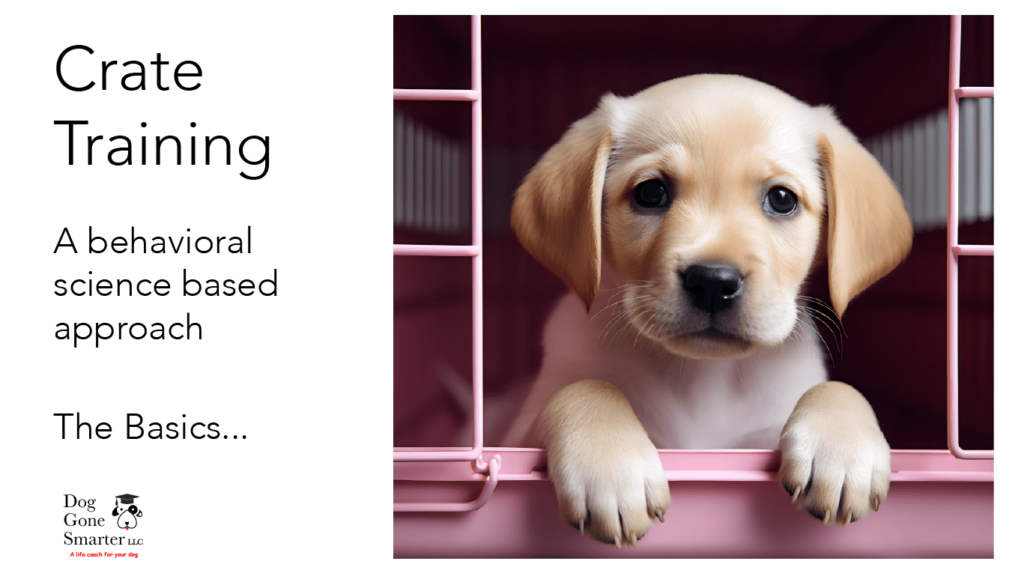Crate Training: The Dog Gone Smarter Approach
Crate training your dog is an essential step in their overall training process. It provides them their own safe space and aids in managing behavior, simplifying travel, and house training. This comprehensive guide aims to demonstrate the benefits of crate training, debunk common myths and misconceptions, and provide step-by-step instructions to successfully crate train your dog using positive reinforcement.
The Concept & Benefits of Crate Training
Crate training is not just about confinement; it’s about creating a personal den-like space where your dog can relax and feel comfortable. This training taps into a dog’s natural instinct to seek a den – a safe, quiet place to rest. The benefits of crate training extend beyond basic house-training.
1. Safety and Security
A crate provides a safe and secure space for your dog. Dogs naturally seek out enclosed spaces for security, making a crate a perfect haven.
2. Simplified Travel
Traveling with a dog is easier and safer when they are crate trained. The familiarity of a crate can make a dog feel more secure during stressful situations like traveling.
3. Emergency Preparedness
In situations such as natural disasters or other emergencies, a crate-trained dog is more manageable, expediting evacuations and reducing stress for both pet and owner.
4. Aids in House Training
Crate training can significantly aid in the house training process. Dogs naturally avoid soiling their sleeping areas, making crate training an effective method for teaching bathroom etiquette.
5. Minimizes Anxiety and Stress-Related Behaviors
Having a trusted safe space can minimize anxiety and stress-related behaviors like whining or restlessness in dogs. It provides them a retreat where they can relax undisturbed.
Debunking Common Misconceptions About Crate Training
Despite its numerous benefits, crate training often faces criticisms and misconceptions. Let’s debunk some of the most common myths.
1. Cruelty Aspect
The most prevalent misconception about crate training is that it’s cruel or punishing. However, when properly introduced, a crate is perceived as a positive space, not a place for punishment.
2. Perception of Confinement
While a crate is indeed a confined space, dogs don’t see it as a restriction when correctly introduced. Instead, they view it as their personal safe space.
3. Age Limitation
Contrary to popular belief, crate training is beneficial for dogs of all ages. Adult dogs can equally benefit from having a designated space that reduces anxiety and helps manage their behavior.
4. Prolonged Confinement
Dogs should not be crated for excessive periods. Crate training should be balanced with ample exercise, mental stimulation, and social interaction.
5. Crate Training as the Sole Method of Potty Training
While crate training can aid in potty training, it’s not a guaranteed solution. Potty training involves a combination of crate training, consistent schedules, and positive reinforcement.
Crate Training: The Importance of Patience and Consistency
Patience and consistency are the pillars of successful crate training. Your dog should form a positive association with the crate, gradually adjusting to spending time in the crate. This routine also aids in building trust between the owner and the dog, which is crucial for a successful crate training experience.
Choosing the Right Crate
Crate selection is a crucial step in the crate training process. The crate should be large enough for your dog to stand, turn around, and lie down comfortably. Both plastic and wire crates have their own advantages and are popular choices among pet parents.
Size
Measure your dog lengthwise from the nose to the tail and add 2-4 inches for the correct crate length, ensuring they have enough room.
Materials
Look for crates with sturdy construction to ensure safety and durability.
Types
- Wire crates – They offer more ventilation and foldable convenience.
- Plastic crates – They provide more privacy and simulate a den-like environment.
Creating a Comfortable Crate Setup
Once the appropriate crate is chosen, the next step is to make it a safe and comfortable resting place. Add a soft blanket or a dog bed for comfort, along with toys for a sense of familiarity.
Bedding
Add a soft blanket or a cushioned dog bed for comfort.
Toys
Place a favorite toy inside to give them a sense of familiarity.
Location
Set the crate in a part of the home where the family spends time to help integrate the crate into daily life.
Accessibility
Ensure the crate door is easy to open and close, reducing stress on both the dog and owner during crate training.
The Crate Training Process
Crate training requires patience and consistency. The goal is to make the crate a positive and safe space where your dog feels calm and relaxed.
1. Introducing Your Dog to the Crate
Firstly, place the crate in a common area of the home where the dog feels comfortable. Keep the door open so they can explore it without feeling trapped. Encourage them to enter by placing their favorite toy or treats near the crate, gradually moving them inside.
2. Feeding and Comfort in the Crate
Once the dog is comfortable entering the crate for treats, begin feeding regular meals near the crate. If they are hesitant, start with the bowl near the crate door, and gradually move it inside.
3. Extending Crate Time Gradually
After your dog feels comfortable with eating in the crate, begin to close the door while they’re eating and reopen it as soon as they finish. Gradually increase the time the door stays closed after meals to help your dog relax and understand that they can be calm and safe in the crate for short periods of time.
4. Dealing with Special Considerations
When crate training an older dog, it’s essential to address the specific challenges they may face. Whether it’s stress related to separation anxiety or health issues that require special care, understanding these factors is crucial for a successful training experience.
Ensuring Ongoing Success
For ongoing success in crate training, it’s essential to focus on consistency, clear training commands, and positive reinforcement.
Consistency
Establishing a consistent daily routine is crucial for a dog to feel secure and learn what to expect in terms of crate time, exercise, and potty breaks.
Clear Training Commands
Verbal commands and cues should remain straightforward and consistent to avoid confusing the dog.
Positive Reinforcement
Positive reinforcement and rewards play a pivotal role in making crate training a pleasant experience. Offer praise and treats immediately after the dog follows a command to reinforce the desired behavior.
Frequently Asked Questions About Crate Training
Crate training a dog requires patience and consistency. Here are some of the most common questions and practical solutions for successful crate training.
1. What is the fastest way to crate train a dog?
The fastest method involves creating positive associations with the crate through the use of treats and favorite toys, and gradually increasing the time the dog spends inside.
2. How do you crate train an adult dog with separation anxiety?
To help a dog with separation anxiety, one should start with short periods of crating while in the room, slowly building up to longer periods and eventually leaving the room. Comfort items and a consistent routine can alleviate stress.
3. How can I retrain my older dog to sleep in its crate comfortably?
Ensure the crate is a welcoming space with comfortable bedding and absence of stress triggers. Introduce crate time gradually, starting with naptime and incrementally working up to overnight stays.
4. What strategies can I use to help an anxious dog become accustomed to a crate?
Strategies include associating the crate with enjoyable activities, such as feeding meals inside, and ensuring it’s a restful, positive space.
5. What are the key benefits of crate training for older dogs?
Crate training can offer older dogs a sense of security, help with house training, and keep them safe during travel or emergencies.
6. How do you introduce a crate to an older dog for the first time?
Introduce the crate gradually by leaving the door open and encouraging exploration with treats. Place comfortable bedding inside and reward the dog for entering voluntarily.
In Conclusion
Crate training is an important part of dog ownership, providing dogs with a personal den-like area where they can relax and feel secure. This comprehensive guide has provided an overview of the benefits of crate training, debunked common misconceptions, and offered a step-by-step guide to successfully crate train a dog using positive reinforcement. Patience, consistency, and understanding your dog’s specific needs are key to successful crate training.


